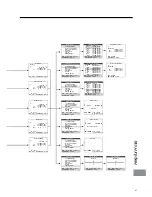
58
Time code
Time Code signals are time data that is recorded on the
tape. The time is expressed in units of hours (h),
minutes (m), seconds (s) and frames (f) (25 frames/
sec). Time codes are recorded concurrently while the
video is being recorded. If a recording is made
continuously from the beginning of a tape, the Time
codes can be used to determine the absolute position of
video and audio recorded on the tape.
When you first record on a new (previously unrecorded)
cassette, the Time codes are also recorded, starting
from zero. If you start recording in the middle of a
cassette that has already been partially recorded, and
you start where the previous recording ended, the Time
code units continue from the ending unit of the previous
recording. However, if you start recording in the middle
of a tape after a blank section of tape, the Time codes
again start from zero.
Unless the Time code is recorded continuously from the
beginning of the tape, precise editing may not be
possible. To ensure that the Time code will be recorded
without interruption, we recommend that you use the
Index Search function before starting to record a new
scene.
Frame
This is a Time code unit. One frame is equivalent to
1/25 of a second. (Refer to the description of Time
codes.)
Tape Counter (Linear counter)
As opposed to the absolute value Time codes (refer to
the explanation of Time codes) that are recorded on
tape simultaneously when video or audio material is
recorded, the tape counter (linear counter) is time
information that can change units. The tape counter is
reset to zero each time a tape is loaded/ejected, and
can also be reset to zero at any other time by pressing
RESET
.
3D-DNR (3-Dimensional Digital Noise Reduction)
To activate the
3D DNR
function, press the
3D DNR
button, so that the “
PB DNR
” or “
REC DNR
” appears on
the VCR display.
3D DNR
function will now reduce the
noise during playback or recording.
Use of “
REC DNR
” during recording reduces the
shaking and distortion that occur during the recording of
analogue tapes so that pictures with a high picture
quality are obtained. Use of “
PB DNR
” when playing
back pictures from an analogue device reduces the
amount of noise, thereby making it possible to view
pictures with a high picture quality.
≥
During playback, the picture may become the
afterimage. In such a case, cancel the
3D DNR
function.
DV TERMINAL
This terminal is used to input/output video and audio
data on digital video equipment. Because the video and
audio data is sent through the
DV
cable as digital
signals, there is practically no deterioration in video and
audio quality after copying. In addition, because the
hardware automatically determines the direction of flow
for input and output signals according to the state of the
unit, there is no need to change the connections around
when switching between input and output, as is the case
with conventional
AV
cables.
In addition, the
DV
terminal on the NV-DV2000 can also
send control signals that are required in editing
operations. If a Panasonic
Digital Video Camera
is
used as the playback unit, only one
DV
cable needs to
be connected between the camera and the NV-DV2000
in order to perform the following editing functions:
Copying
,
Assemble
,
Video Insert
, and
Audio
Insert
.
(Such a configuration does not permit
AV Insert
,
Audio Dubbing
, or
Audio Mixing
.
AV
cables must
also be connected.)
The following functional differences exist when the
recording unit and the playback unit are connected
through the
DV
terminal, as opposed to when they are
connected through the audio and video sockets:
≥
The original sub code data (date of the recording,
photoshot index signals, etc.) on the playback unit is
copied as is on the recording unit.
(Time codes are not copied.)
≥
The audio is recorded in the same mode (12bit or
16bit) on the recording unit as it was on the playback
unit. (If you want to change the audio recording
mode, the units must be connected through the audio
and video sockets, not the
DV
terminal.)
≥
No audio is output while searching with the
Jog Dial/
Shuttle Ring.
≥
When playing a tape that was recorded with two audio
channels (main and sub; from a bilingual broadcast,
for example), both the main audio channel and the
sub audio channel are output, regardless of the audio
select (main/sub) setting.
≥
Horizontal sway may appear at the bottom of the
screen for video input from the
DV
terminal, but this
has no effect on the recording.
Summary of Contents for NV-DV2000EC
Page 67: ...67 ...











































